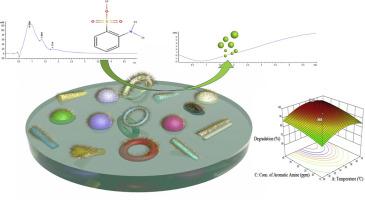当前位置:
X-MOL 学术
›
J. Microbiol. Methods
›
论文详情
Our official English website, www.x-mol.net, welcomes your feedback! (Note: you will need to create a separate account there.)
Application of novel bacterial consortium for biodegradation of aromatic amine 2-ABS using response surface methodology.
Journal of Microbiological Methods ( IF 2.2 ) Pub Date : 2020-05-17 , DOI: 10.1016/j.mimet.2020.105941 Masoom Fatima 1 , Muhammad Saeed 2 , Muhammad Aslam 3 , Rakel Wreland Lindström 4 , Robina Farooq 5
Journal of Microbiological Methods ( IF 2.2 ) Pub Date : 2020-05-17 , DOI: 10.1016/j.mimet.2020.105941 Masoom Fatima 1 , Muhammad Saeed 2 , Muhammad Aslam 3 , Rakel Wreland Lindström 4 , Robina Farooq 5
Affiliation

|
There is a strong need to develop purification methods for textile industrial wastewater containing toxic azo dyes. The reductive cleavage of azo dyes can be made by anaerobic bacteria, but the products of aromatic amines require an aerobic process. In this study a novel bacterial dye degrading consortium (DDC) of five isolated strains identified with 16S rRNA sequence: Proteus mirabilis (KR732288), Bacillus anthracis (KR732289), Enterobacter hormaechei (KR732290), Pseudomonas aeruginosa (KR732293) and Serratia rubidaea (KR732296) were used to aerobically decompose metabolite 2-aminobenxenesulfonic acid (2-ABS), as a model compound. The effect of three variables: temperature (28-42 °C), pH (5.0-8.0) and initial concentration of 2-ABS (5-40 ppm) was investigated in terms of degradation and chemical oxygen demand (COD) removal. Central composite design matrixand response surface methodology (RSM) were used for experimental design to evaluate theinteraction of the three process variables. The results show that up to 95% degradation and COD 90% removal are possible at optimal values of 32.4 ppm 2-ABS, pH 6.6 and a temperature of 35.7 °C. The theoretical response variables predicted by the developed RSM model was supported the experimental results. The optimized degradation of 2-ABS and COD removal were further confirmed by UV-HPLC analysis.
中文翻译:

新型细菌联合体在响应面法生物降解芳香胺2-ABS中的应用。
迫切需要开发一种用于含有毒性偶氮染料的纺织工业废水的净化方法。偶氮染料的还原裂解可以通过厌氧细菌进行,但是芳香胺的产物需要好氧过程。在这项研究中,一个由五个分离的菌株组成的新型细菌染料降解协会(DDC)具有16S rRNA序列:变形杆菌(KR732288),炭疽芽孢杆菌(KR732289),霍马肠杆菌(KR732290),铜绿假单胞菌(KR732293)和红粘菌)被用于需氧分解代谢物2-氨基苯磺酸(2-ABS),作为模型化合物。从降解和化学需氧量(COD)的角度研究了温度(28-42°C),pH(5.0-8.0)和2-ABS初始浓度(5-40 ppm)这三个变量的影响。使用中央复合设计矩阵和响应面方法(RSM)进行实验设计,以评估三个过程变量之间的相互作用。结果表明,在最佳值为32.4 ppm 2-ABS,pH 6.6和温度为35.7°C的情况下,降解率最高可达95%,COD去除率高达90%。由开发的RSM模型预测的理论响应变量为实验结果提供了支持。通过UV-HPLC分析进一步证实了2-ABS的最佳降解和COD去除。由开发的RSM模型预测的理论响应变量为实验结果提供了支持。通过UV-HPLC分析进一步证实了2-ABS的最佳降解和COD去除。由开发的RSM模型预测的理论响应变量为实验结果提供了支持。通过UV-HPLC分析进一步证实了2-ABS的最佳降解和COD去除。
更新日期:2020-05-17
中文翻译:

新型细菌联合体在响应面法生物降解芳香胺2-ABS中的应用。
迫切需要开发一种用于含有毒性偶氮染料的纺织工业废水的净化方法。偶氮染料的还原裂解可以通过厌氧细菌进行,但是芳香胺的产物需要好氧过程。在这项研究中,一个由五个分离的菌株组成的新型细菌染料降解协会(DDC)具有16S rRNA序列:变形杆菌(KR732288),炭疽芽孢杆菌(KR732289),霍马肠杆菌(KR732290),铜绿假单胞菌(KR732293)和红粘菌)被用于需氧分解代谢物2-氨基苯磺酸(2-ABS),作为模型化合物。从降解和化学需氧量(COD)的角度研究了温度(28-42°C),pH(5.0-8.0)和2-ABS初始浓度(5-40 ppm)这三个变量的影响。使用中央复合设计矩阵和响应面方法(RSM)进行实验设计,以评估三个过程变量之间的相互作用。结果表明,在最佳值为32.4 ppm 2-ABS,pH 6.6和温度为35.7°C的情况下,降解率最高可达95%,COD去除率高达90%。由开发的RSM模型预测的理论响应变量为实验结果提供了支持。通过UV-HPLC分析进一步证实了2-ABS的最佳降解和COD去除。由开发的RSM模型预测的理论响应变量为实验结果提供了支持。通过UV-HPLC分析进一步证实了2-ABS的最佳降解和COD去除。由开发的RSM模型预测的理论响应变量为实验结果提供了支持。通过UV-HPLC分析进一步证实了2-ABS的最佳降解和COD去除。



























 京公网安备 11010802027423号
京公网安备 11010802027423号